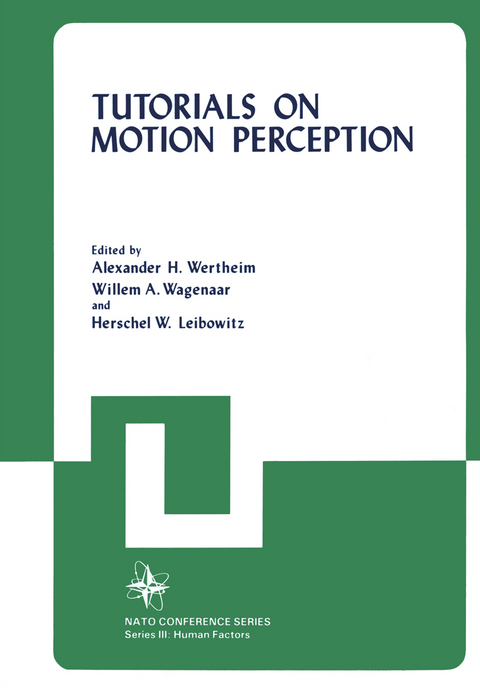
Tutorials on Motion Perception
Springer-Verlag New York Inc.
978-1-4613-3571-9 (ISBN)
From August 24-29, 1980 the international "Symposium on the Study of Motion Perception; Recent Developments and Applications", sponsored by NATO and organized by the editors of this book, was held in Veldhoven, the Netherlands. The meeting was attended by about eighty scholars, including psychologists, neurologists, physicists and other scientists, from fourteen different countries. During the symposium some fifty research papers were presented and a series of tutorial review papers were read and discussed. The research presentations have been published in a special issue of the international journal of psychonomics "Acta Psychologica" (Vol. 48, 1981). The present book is a compilation of the tutorial papers. The tutorials were arranged around early versions of the chapters now appearing in this book. The long discussions at the Veldhoven tutorial sessions resulted in extensive revisions of the texts prior to this publication. Unfortunately this led to a delay in publication, but we feel that this was justified by a greater depth of understanding which, in our opinion, has significantly increased the quality of the book. As they now stand, the chapters cover most of the issues relevant to the study of motion perception. Also they clearly reflect the intensive exchange of knowledge that took place during the symposium. As such we think that this book can be used both as an advanced text for students and scientists alike and as a comprehensive reference source.
Eye Movement and Motion Perception.- Summary.- 1. Three Stimuli for Motion Compared.- 2. Paths that Result from a Combination of Independent Motion Processes.- 3. Comparison of Three Stimuli for Motion Continued.- 4. Compensatory Eye Movement.- 5. Adaptation as Changed Evaluation of Compensatory Eye Movements.- References.- Visual Space Perception Through Motion.- Summary.- 1. Proximal Stimulus as an Optic Flow.- 2. About the Perceptual Vector Analysis as Demonstrated in Object Motion Research.- 3. About Perception of the Environment as a Fundamental Frame of Reference for Visual Perception.- 4. Concluding Remarks.- References.- Thresholds of Motion Perception.- 1. A Classification of Motion Displays.- 2. Assumptions and Processes in Motion Detection.- 3. Experimental Findings.- 4. Effects of Retinal Eccentricity.- 5. Conclusions.- Acknowledgement.- References.- Psychophysics of Motion Perception.- Summary.- 1. Stimuli and Dependent Measures.- 2. Elements of a Model.- 3. Extensions to the Simple Model.- 4. Studies of Stimulus Uncertainty.- References.- Visual Localization and Eye Movements.- 1. Introduction.- 2. Theories of Perceptual Stability.- 3. Localization with Steady Gaze.- 4. On Separating Visual Localization from Sensory/Motor Localization.- 5. Localization in the Presence of Saccadic Eye Movements.- 6. Concluding Remarks.- Footnotes.- References.- Linear Self Motion Peception.- 1. Role of the Otoliths in Linear Self Motion Perception.- 2. Models of Linear Motion Perception of Otolithic Origin.- 3. The Perception of Self Motion Induced by the Visual System.- 4. Visual Vestibular Interaction in Linear Self Motion Perception.- References.- Neural Substrates of the Visual Perception of Movement.- 1. Definitions.- 2. Criteria for Establishing the Neural Substratesof Movement Perception.- 3. Experimental Data.- 4. Conclusions.- Acknowledgements.- References.- Implications of Recent Developments in Dynamic Spatial Orientation and Visual Resolution for Vehicle Guidance.- 1. The Two Modes of Processing Concept.- 2. The Multisensory Nature of Spatial Orientation.- 3. Anomalous Myopias and The Intermediate Dark-Focus Ofaccommodation.- 4. Some Implications for Selection, Licensing, and Training.- References.
| Reihe/Serie | III Human Factors | Nato Conference Series ; 20 |
|---|---|
| Zusatzinfo | 263 p. |
| Verlagsort | New York, NY |
| Sprache | englisch |
| Maße | 170 x 244 mm |
| Themenwelt | Sachbuch/Ratgeber ► Natur / Technik ► Garten |
| Naturwissenschaften ► Physik / Astronomie ► Allgemeines / Lexika | |
| ISBN-10 | 1-4613-3571-X / 146133571X |
| ISBN-13 | 978-1-4613-3571-9 / 9781461335719 |
| Zustand | Neuware |
| Haben Sie eine Frage zum Produkt? |
aus dem Bereich


